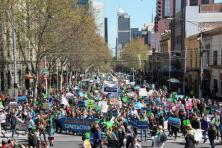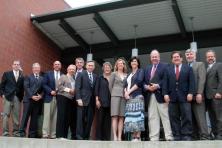In “Global Warming’s Terrifying New Math” published in the August 2, 2012 Rolling Stone, Bill McKibben makes the compelling case that the average global temperature is well on its way to increasing two degrees Celsius—and possibly higher.
Two degrees Celsius represents what scientists consider safe for life as we know it on Earth and is also the upper limit that countries agreed upon in the Copenhagen Accord. As potentially dangerous as this scenario may be, the International Energy Agency’s chief economist actually sees the current emissions trend as more likely to result in six degrees Celsius.
Underlying these conclusions is some basic math. In 2011 the Carbon Tracker Initiative calculated the carbon that the fossil fuel industry currently plans to burn based on fossil fuel reserves that are in the ground and are already counted as multi-trillion dollar assets on corporate balance sheets.
To stay within the two degrees Celsius limit, scientists reason, global society collectively has a carbon budget of 565 gigatons between now and mid-century. But based on current reserves and balance sheets we can expect the fossil fuel industry to emit more than five times that amount, or 2,795 gigatons.
Companies and individuals with enormous political power stand to lose mightily from if this massive burning of fossil fuels is halted. As McKibben writes, “If you paid attention to the scientists and kept 80 percent of [fossil fuel reserves] underground, you’d be writing off $20 trillion in assets.” In other words, they have a clear interest in avoiding regulation or other measures that would help reduce the emissions problem.
Powerful as the Goliath fossil fuel industry may seem, our future is yet to be determined and cities around the world are engaged in some serious math of their own that is aimed at significantly reducing fossil fuel consumption.
It is well known that cities organized to adopt greenhouse gas emissions reduction targets consistent with the Kyoto Protocol goals when countries such as the US would not ratify that international treaty. Lesser known is the work that cities have done in the intervening years to make the projects happen that would achieve the related targets.
Issaquah, WA set an ambitious carbon goal: to reduce greenhouse gas emissions 80 percent below its 2007 level by the year 2050, and incorporated that target into its Comprehensive Plan. Issaquah has worked with New Energy Cities to understand the order of magnitude of actions that will be necessary to meet this goal in the long term, and to set practical intermediate targets that would put the community on the critical path to get there.
This collaboration will result in a detailed “carbon wedge analysis” inspired by Princeton University’s Carbon Mitigation Initiative and a Sustainable Energy Strategy that builds on Issaquah’s groundbreaking zHome. (The Pembina Institute conducted a similar wedge analysis for the City of Calgary, British Columbia.)
Burlington, VT set an 80 percent reduction goal and contracted with Spring Hill Solutions, a local consulting firm, to conduct an analysis of the carbon reduction values, costs, and financial savings associated with a series of strategies identified by that community. The presentation of their findings mirrored a 2007 McKinsey report: showing each strategy’s “carbon bang for the investment buck” and offering recommendations for how to bundle multiple strategies (some with costs, some with savings) that if executed together would end up cost-neutral.
Austin, TX requires new single-family homes to be zero-energy capable by 2015. Jackson, WY has pledged to mitigate up to one-third of its projected energy load growth with a combination of deep energy efficiency and renewable energy, and to date has already installed 4 MW of renewable energy. Bainbridge Island, WA residents committed to reduce nearly 7,000 metric tons of greenhouse gas emissions by 2013, primarily through residential energy efficiency retrofits augmented by community solar.
Work at the local level is not limited to goal-setting alone, nor are cities constraining themselves to the 80 percent goal. Communities from Fort Collins, CO to Oberlin, OH are going net-zero with fervor and creativity. Fort Collins has woven together an impressive collaboration between the City, the municipal energy and water utility, Colorado Clean Energy Cluster, Colorado State University, New Belgium Brewery, and an array of private sector technology companies to develop the nation’s first net-zero energy district, FortZED. With the collaboration of the Clinton Foundation Climate Positive Development Program, Oberlin is making progress toward its goal of going beyond carbon-neutral by sourcing renewable energy and sinking more carbon than the community emits in a given period of time.
These are just a few examples of the small- and medium-sized cities around the United States that are doing the hard math of carbon emissions reduction and finding economic benefits to setting meaningful carbon reduction goals. For example, the Long Island Green Homes program, initiated by the Town of Babylon, NY in 2008 to reduce the carbon footprint of each participating household by 20-40 percent, supports more than 50 full-time jobs.
In Bellingham, WA, the Community Energy Challenge for residential and commercial energy efficiency has supported 28 local jobs. More catalytic communities and projects are profiled in New Energy Cities’ recent report, Powering the New Energy Future From the Ground Up: Profiles in City-Led Energy Innovation.
These examples are not reasons for letting up the pressure to keep fossil fuels in the ground, but they are evidence that a different future is possible and happening now. The question will be, as McKibben wrote in his Rolling Stone article, how quickly can these solutions scale up?




